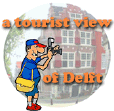


Registration of properties in strata
. |
|
 |
|
Registration of properties in strata |
|
| The workshop on 3D Cadastres will be organised at the University of Technology in Delft, one of the most beautiful scenic cities in the Netherlands. |  |
Why a workshop on 3D Cadastres A cadastre is usually, and in most countries, a parcel-based, and up-to-date land information system containing records of interests in land (rights, restrictions and responsibilities). It usually includes a geometric description of land parcels linked to other records describing the nature of the interests, the ownership or control of those interests, and often the value of the parcel and its improvements [1]. Some countries do however also register apartments and other structures above or under the surface as property objects in line with parcels on the surface. In this workshop the cadastre is seen in relation to land registration as one system of land administration. Until now, the legal boundaries of parcels used for the registration of the legal status are usually fixed in 2D space. It is difficult to reflect the vertical dimension of the legal status of real estate objects, which may be important in current cadastres with most 3D relationships registered administratively, as an attribute of defined parcels, using condominium or strata title legislation. In areas with an intensive use of land, there is a growing interest in using space under and above the surface. To be able to define and manage the juridical situation satisfactory, 3D information becomes therefore indispensable in registering today's world. More and more situations occur in which the vertical dimension is an important factor in registering the legal status of real estate objects. Land Registration Offices and Cadastres throughout the world are being confronted to register those situations within the current registration possibilities. Since it is expected that Land Registration Offices and Cadastres will meet registration complications in the future, the way to register the legal status of real estate objects for which the third dimension is a matter of importance. It will be a challenge to science to find the right geometric descriptions. The aim of the workshop on 3D Cadastres is to consider the 3D issue of cadastral registration in an international context. The workshop will be organised as part of the activity of Commission 7 (Cadastre and Land Management), International Federation of Surveyors (FIG). The possibility to register property in three dimensions efficiently (including under and above the surface) will facilitate the separate use of spaces. It should also stimulate the improvement of the legal security of spatially complex rights. It may be expected that the workshop will form the start of international FIG discussions on 3D Cadastres as the next 2002-2008 FIG workplans will be approved not earlier then in 2002. FIG Commission 7 and the Bureau of the UN Economic Commission for Europe Working Party on Land Administration (WPLA) encourage this workshop. The workshop
Scope and mission
It will be an open workshop for a limited number of participants originating from countries which encountered the 3D problem and who are interested to discuss the issue in an international forum. The workshop addresses in particular:
Besides the presenters of selected papers, the participants will be chosen on the basis of geographical and legal context and the date of registration. The workshop will conclude with a report to FIG Commission 7 and to WPLA. Program
committee
Organising
committee
|
|
![]()